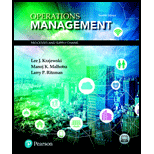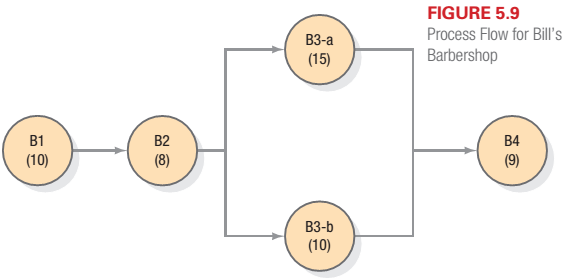
Concept explainers
Bill’s Barbershop has two barbers available to cut customers’ hair. Both barbers provide roughly the same experience and skill, but one is just a little bit slower than the other. The process flow in Figure 5.9 shows that all customers go through Steps Bi and B2 and then can be served at either of the two barbers at Step B3. The process ends for all customers at Step B4. The numbers in parentheses indicate the minutes it takes that activity to process a customer.
- How long does it take the average customer to complete this process?
- What single activity is the bottleneck for the entire process?
- How many customers can this process serve in an hour?

Want to see the full answer?
Check out a sample textbook solution
Chapter 5 Solutions
Operations Management: Processes and Supply Chains (12th Edition) (What's New in Operations Management)
Additional Business Textbook Solutions
Loose-leaf for Operations Management (The Mcgraw-hill Series in Operations and Decision Sciences)
Operations Management, Binder Ready Version: An Integrated Approach
Principles of Operations Management: Sustainability and Supply Chain Management (10th Edition)
Principles Of Operations Management
Business in Action (8th Edition)
- I already find a. I need help with b Bill's Barbershop has two barbers available to cut customer's hair. Both barbers provide roughly the same experience and skill, but one is just a little bit slower than the other. The process flow below shows that all customers go through steps B1 and B2 and then can be served at either of the two barbers at step B3. The process ends for all customers at step B4. The numbers in parentheses indicate the minutes it takes that activity to process a customer. b. What single activity is the bottleneck for the entire process? B what?arrow_forwardHow does seasonal variability in demand affect the l ow and waiting time through a process? How might a company respond to reduce the effect of this variability?arrow_forwardThe Holt Million Corporation’s plant manufactures two different products: X and Y. The plant has three different machines: A, B, and C. Each performs different tasks and can work on only one unit of material at a time. Details for each product are shown in the table below: Product X Y Demand Per Week 200 units 100 units Selling Price $150 $160 Machine Operation Required A, B, C B, B, C Operation Times in Minutes 20, 15, 15 15, 15, 15 Raw Materials Needed RM-1, RM-2 RM-2, RM-3 Raw Materials Costs RM-1 = $40/unit, RM-2 or RM-3 = $20/unit Each product uses raw materials with costs as shown in the above table where the processing times and the machine required for each operation are also shown. Each machine is available 4,800 minutes per week. There are no system foul-ups. Demand is deterministic (i. e., no uncertainty). Operating expenses, including labor (but excluding raw materials) total $12,000 per week. Assuming…arrow_forward
- Mr. K’s is a very popular hair salon. It offers high quality hairstyling andphysical relaxation services at a reasonable price, so it always has unlimiteddemand. The service process includes five activities that are conducted inthe sequence described below ( the time required for each activity is shownin parenthesis):Activity 1: Welcome a guest and offer homemade herb tea (10 minutes)Activity 2: Wash and condition har (10 minutes)Activity 3: Neck, shoulder, and back stress release massage (10 minutes)Activity 4: Design and hair style and do the hair (25 minutes)Activity 5: Ring up the guest bill (5 minutes)Each activity has one employee dedicated to it. For the following questions,assume unlimited demand. Also assume that the employee at activity 1 onlyadmits new guests at the rate of the bottleneck.(a) Which resource is the bottleneck?(b) What is the capacity of the process?(c) What is the flow rate?(d) What is the utilization of the employee at activity 3(e) What is the cycle time?arrow_forward. The School of Dentistry at Penn provides general dental care to residents of Philadelphiaon a walk-in basis. Upon arrival, customers first provide health-relevant informationsuch as personal health records and insurance provider to a receptionist who entersthe information into the computer system for the dentist to see. A dental assistant thentakes an X-ray of the patient. A dentist then performs the checkup and discusses anyissues with the patient. Depending on the day, patients might have to wait at any of theseresources. This concludes the process. Draw a process flow diagram of this process.arrow_forwardHow does seasonal variability in demand affect the flow and waiting time through a process? How might a company respond to reduce the effect of this variability?arrow_forward
- A production line is a set of sequential operations established in a factory plant where components are assembled to make a finished product or where materials are put through a refining process to produce an end-product that is suitable for onward consumption. Ford have seven production lines in their manufacturing plant for their automotive parts where each production line produces 120, 100, 80, 116, 77, 94, 112 output per day. (a) As the Production Manager at Ford, you are required to submit the daily report of the production plant. Calculate the mean, median, and mode from the data based on the output that has been provided. (b) Also calculate the three critical parameters for measuring spread in the following ways: Range Variance Standard Deviationarrow_forwardn a manufacturing process, a molded part spends 7 hours in inventory before being placed in a deburring machine, where the part is processed for 2 minutes. After deburring, the part spends 4 hours in inventory waiting for its turn on the polishing machine. The part then spends 7 minutes in polishing before waiting 6 hours in line to be painted. The part goes through a painting process that takes 7 minutes, then spends 11 hours in inventory before being shipped to the customer. What is the percentage of value-added time for the part?arrow_forwardBill’s Car Wash offers two types of washes: Standard and Deluxe. The process flow for both typesof customers is shown in Figure 5.7. Both wash types are first processed through steps A1 and A2.The Standard wash then goes through steps A3 and A4 while the Deluxe is processed through steps A5,A6, and A7. Both offerings finish at the drying station (A8). The numbers in parentheses indicate theminutes it takes for that activity to process a customer a. Which step is the bottleneck for the Standard car wash process? For the Deluxe car wash process?b. What is the capacity (measured as customers served per hour) of Bill’s Car Wash to processStandard and Deluxe customers? Assume that no customers are waiting at step A1, A2, or A8.c. If 60 percent of the customers are Standard and 40 percent are Deluxe, what is the average capacityof the car wash in customers per hour?d. Where would you expect Standard wash customers to experience waiting lines, assuming that newcustomers are always entering…arrow_forward
- Bill’s Barbershop has two barbers available to cut customers’ hair. Both barbers provide roughly the same experience and skill, but one is just a little bit slower than the other. The process flow in Figure shows that all customers go through steps B1 and B2 and then can be served at either of the two barbers at step B3. The process ends for all customers at step B4. The numbers in parentheses indicate the minutes it takes that activity to process a customer.a. How long does it take the average customer to complete this process?b. What single activity is the bottleneck for the entire process?c. How many customers can this process serve in an hour?arrow_forwardMiss Felicia is the owner of a homestay business under the registered name of FNB Hospitality Enterprise. The business runs ten units of homestay in Kuala Lumpur and Selangor. In addition to homestays bookings, Miss Felicia also receives bookings for events and meals delivery during the guests’ stay. Recently, due to the lifting of the movement control order (MCO), there are increasing requests and bookings made by the guests. Miss Felicia is overwhelmed with the processes since she is using a manual system in managing all bookings and requests, which are recorded in a logbook. There were incidents of overlapping and missing bookings and payments received. On several occasions, meals were not delivered as promised. Miss Felicia is worried that these incidents could affect her business’s reputation and sales. Therefore, she is urgently considering a new system to support FNB Hospitality business. She is also interested to consider a platform or a system that could help the business…arrow_forwardL. Winston Martin (an allergist) has an excellent system for handling his regular patients who come in just for allergy injections. Patients arrive for injection and fill out a name slip, which is then placed in an open slot that passes into another room staffed by one or two nurses. The specific injections for a patient are prepared, and the patient is called through a speaker system into the room to receive the injection. At certain times during the day, patient load drops and only one nurse is needed to administer the injections. Let’s focus on the simpler case of the two—namely when there is one nurse. Also, assume that patients arrive in a Poisson fashion and the service rate of the nurse is exponentially distributed. During this slower period, patients arrive with an interarrival time of approximately three minutes. It takes the nurse an average of two minutes to prepare the patients’ serum and administer the injection.a. What is the average number you would expect to see in Dr.…arrow_forward
 Practical Management ScienceOperations ManagementISBN:9781337406659Author:WINSTON, Wayne L.Publisher:Cengage,
Practical Management ScienceOperations ManagementISBN:9781337406659Author:WINSTON, Wayne L.Publisher:Cengage,
